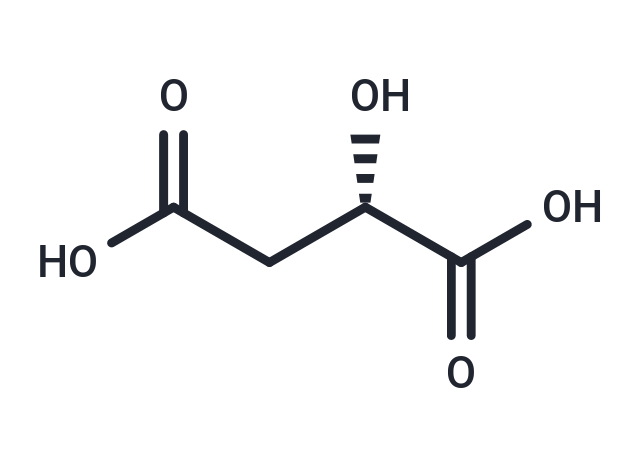 Your shopping cart is currently empty
Your shopping cart is currently empty

(S)-Malic acid (Standard) is the standard substance of (S)-Malic acid, and it is applicable for quantitative analysis, quality control, and related research in biochemical experiments. (S)-Malic acid ((S)-2-Hydroxysuccinic acid) is a tart-tasting organic dicarboxylic acid that plays a role in many sour or tart foods. Apples contain malic acid, which contributes to the sourness of a green apple. Malic acid can make a wine taste tart, although the amount decreases with increasing fruit ripeness. (wikipedia). In its ionized form malic acid is called malate. Malate is an intermediate of the TCA cycle along with fumarate. It can also be formed from pyruvate as one of the anaplerotic reactions. In humans, malic acid is both derived from food sources and synthesized in the body through the citric acid cycle or Krebs cycle which takes place in the mitochondria. Malate's importance to the production of energy in the body during both aerobic and anaerobic conditions is well established. Under aerobic conditions, the oxidation of malate to oxaloacetate provides reducing equivalents to the mitochondria through the malate-aspartate redox shuttle. During anaerobic conditions, where a buildup of excess of reducing equivalents inhibits glycolysis, malic acid's simultaneous reduction to succinate and oxidation to oxaloacetate is capable of removing the accumulating reducing equivalents. This allows malic acid to reverse hypoxia's inhibition of glycolysis and energy production. In studies on rats it has been found that only tissue malate is depleted following exhaustive physical activity. Other key metabolites from the citric acid cycle needed for energy production were found to be unchanged. Because of this, a deficiency of malic acid has been hypothesized to be a major cause of physical exhaustion. Notably, the administration of malic acid to rats has been shown to elevate mitochondrial malate and increase mitochondrial respiration and energy production.

| Pack Size | Price | USA Warehouse | Global Warehouse | Quantity |
|---|---|---|---|---|
| 500 mg | $75 | 7-10 days | 7-10 days |
| Description | (S)-Malic acid (Standard) is the standard substance of (S)-Malic acid, and it is applicable for quantitative analysis, quality control, and related research in biochemical experiments. (S)-Malic acid ((S)-2-Hydroxysuccinic acid) is a tart-tasting organic dicarboxylic acid that plays a role in many sour or tart foods. Apples contain malic acid, which contributes to the sourness of a green apple. Malic acid can make a wine taste tart, although the amount decreases with increasing fruit ripeness. (wikipedia). In its ionized form malic acid is called malate. Malate is an intermediate of the TCA cycle along with fumarate. It can also be formed from pyruvate as one of the anaplerotic reactions. In humans, malic acid is both derived from food sources and synthesized in the body through the citric acid cycle or Krebs cycle which takes place in the mitochondria. Malate's importance to the production of energy in the body during both aerobic and anaerobic conditions is well established. Under aerobic conditions, the oxidation of malate to oxaloacetate provides reducing equivalents to the mitochondria through the malate-aspartate redox shuttle. During anaerobic conditions, where a buildup of excess of reducing equivalents inhibits glycolysis, malic acid's simultaneous reduction to succinate and oxidation to oxaloacetate is capable of removing the accumulating reducing equivalents. This allows malic acid to reverse hypoxia's inhibition of glycolysis and energy production. In studies on rats it has been found that only tissue malate is depleted following exhaustive physical activity. Other key metabolites from the citric acid cycle needed for energy production were found to be unchanged. Because of this, a deficiency of malic acid has been hypothesized to be a major cause of physical exhaustion. Notably, the administration of malic acid to rats has been shown to elevate mitochondrial malate and increase mitochondrial respiration and energy production. |
| Synonyms | L-Malic acid (Standard) |
| Molecular Weight | 134.09 |
| Formula | C4H6O5 |
| Cas No. | 97-67-6 |
| Smiles | [C@H](CC(O)=O)(C(O)=O)O |
| Relative Density. | 1.60 g/cm3 |
| Storage | store at -80°C |
| Size | Quantity | Unit Price | Amount | Operation |
|---|

Copyright © 2015-2026 TargetMol Chemicals Inc. All Rights Reserved.